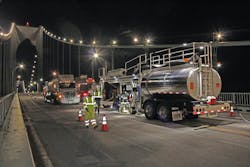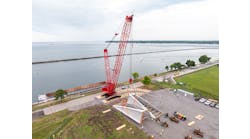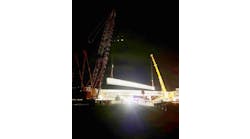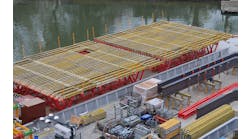In a typical bridge construction project, the designers do their part, engineers do their part and pavement and bridge contractors do their part . . . but too often the zone between the bridge and the road is left with a figurative, and sometimes literal, gap. This small, neglected region becomes a no-man’s-land that is then prone to several disruptive physical conditions, which are usually perceived by drivers as “the bump at the end of the bridge.”
The public may have come to expect rough rides on bridges, but this situation has had an overall negative impact on their impression of the highway system. Furthermore, roughness leads to increased vehicle wear and damage, increased cargo damage and increased freight costs. Rough conditions can even adversely affect safety, because they interfere with vehicle handling and grip. The owner bears costs as well. Pavement and bridge life are reduced; maintenance costs are increased; there is added risk to maintenance workers; and snow and ice removal is made more difficult.
Some of the primary difficulties in designing and maintaining a bridge/road interface are intrinsic and stem from the varying support conditions at and around bridges. That is, roads leading up to bridges are usually supported on natural, and only slightly modified, soils; approach slabs in close proximity to the bridge are supported on backfill; immediately past the approach ramp, deep foundations support the bridge itself; and finally, as the bridge approaches its midpoint, the stiffness of support diminishes. Since uniform support conditions are key to the integrity of pavements, this is indeed a significant challenge.
Other causal factors for approach-pavement roughness can be attributed to design and construction details and specs. Over the past five years, Ohio’s DOT has led the way in identifying a solution in these areas. They worked with Iowa State University to complete in-depth research and ultimately ISU proposed a solution in which a multidisciplined approach could be taken.
“There have really been two major issues at hand,” said Brian Schleppi, manager, Infrastructure Management Section, Office of Technical Services for the Ohio Department of Transportation (ODOT). “First, can we build a smooth-riding bridge encounter in the first place? We found that our existing straightedge and profilograph specifications did little to ensure good rideability so we focused on creating a spec that would be based on rideability (IRI). Second, what good is it if we build it smooth initially and it doesn’t last due to differential settlement issues or erosion problems? The latter we’ve tried to address by looking at the problem from the design, material, geotechnical and construction perspectives.”
Quantifying the problem
Rideability can be defined as seeing the surface of a highway the way motor vehicles do—specifically, the way a vehicle’s suspension system does. This is not a subjective measurement (though nothing speaks more clearly to the problem than the dramatic, head-cracking jolts that drivers experience as their vehicles rumble over a particularly nasty bump); IRI numbers have become an important measure of highway rideability. IRI numbers have been in use since the 1980s, but only now are they being employed to address the area of intersection between a bridge approach and the bridge itself.
Certain distances of roughness events are associated with a more dramatic driver experience. Shorter or choppier events along a roadway result in wheel hop, while longer events can cause the whole vehicle to bounce. Inertial profilers capture these significant lengths better than other methods, making IRI numbers very accurate in capturing the kind of roughness that takes a toll on vehicle-suspension systems in the real world—roughness that is seen particularly often around bridges. In fact, Ohio found that bridges increase system IRI by 7.5%, even though they account for less than 4% of system length.
Smoothness specs have long existed for pavement and also for bridge decks and approach slabs—but no specs existed for the transitions between these areas, explained Schleppi. He points out that if we begin to calculate the IRI over the transition points from road to approach to bridge, we should be able to catch and correct more of our current trouble spots. “Our solution is to look at things a little more holistically. Let’s look at a little bit of pavement on each side of the bridge and everything in between when we calculate the IRI.”
As a result of ODOT’s holistic approach, Ohio is the first state to implement IRI-based smoothness specifications for bridges in a comprehensive manner. And the specifications pioneered by ODOT are beginning to be adopted by other states. Nilesh Surti, state pavement construction engineer for NCDOT’s Construction Unit, consulted with Schleppi during the development of North Carolina’s IRI smoothness criteria for structures.
“Now we are trying it out for bridges,” said Surti.
He said that one of the NCDOT division offices recently contacted him with concerns over a 2.5-mile-long coastal region bridge which needed profiling. Currently, the state uses a Rainhart profilograph that has to be manually pushed.
“It takes one or two guys to push it the entire length of the bridge. It adds risk to the operators and it takes a long time,” he said.
Surti took inertial profiler result data from another long bridge where North Carolina had conducted tests and used that data as a base for the smoothness numbers for the new IRI bridge-rideability specification. Later this year, the spec will be put into one contract as a special provision for the coastal bridge work, making it a pilot project which may eventually lead to wider implementation. If all goes well:
“I’ll talk to the structure management group about adopting this spec for all long bridges in North Carolina based on a length criteria,” said Surti. Eventually, North Carolina is likely to follow Ohio’s lead in measuring IRI smoothness across the entire bridge transition. “We will start at the approach and calculate IRI across the entire length of the bridge. My goal is to get rid of the bump. We will encourage the bridge contractors and roadway contractors to work together on getting better results.”
The research process
One focus of the ISU study was to identify a process for tracking deterioration and determining just when corrective actions are needed. Schleppi cited one factor that was found to be affecting real-world bridge performance: Sometimes temperature swings were greater than what had been expected or designed for. Also, some concrete in service had higher coefficients of expansion than were traditionally designed for. These two factors meant that higher forces than expected were being experienced in the field, contributing to increased roughness. ISU went on to physically test Ohio’s bridges and conduct laboratory tests. Eventually they identified support soil conditions to be a particular area for improvement.
It is common for earth movement under approach slabs to cause structural problems in various bridge and decking components. Voids underneath approach slabs also are common, due to settlement or improper drainage mechanisms that lead to material erosion.
“One of the things we found,” said Schleppi, “is that by using standard approach-slab lengths—typically 15-25 ft—we often end up with slabs that don’t span the distance between the undisturbed constructed embankment and the back wall. This translates into a major problem over the long term causing differential settlement and sometimes erosion that allows the approach slab sink on the pavement side. The challenge is to find a means of preventing this.”
A key finding that came out of the ISU study was that there are significant issues pertaining to moisture content in granular materials and these issues affect the ability to achieve proper compaction under an approach slab. Certain popular fill materials, such as sand, are in fact extremely prone to settlement. Even with efforts at settlement mitigation, it is common for surface water to be forced into undesirable escape pathways. In addition to considering alternate materials, recommendations from ISU included developing a lab test protocol for granular backfill materials and improving compaction efforts on-site by using vibratory compactors.
Design, construction and beyond
A recurring theme in the research is that, quite often, design theory is not borne out in practice. Recommendations from ISU include several potential alterations in the design phase, ranging from reconfigured expansion joints to the casting of approach slabs on a low-friction material. During the construction phase of a project, an increased number of inspections may help improve a pavement’s ultimate durability.
ISU also advises that special consideration be given to the thickness of concrete cover on structures where unusual or unproven construction practices are being used to accommodate the possibility of corrective grinding.
“There is a sweet spot in how much concrete you need over your reinforcing steel,” said Schleppi. “Too much or too little cover will cause excessive cracking. There is a ‘magic’ cover thickness that reduces cracking. In Ohio, we design for 1.5-in. cover, with an additional 1 in. for deck wear. Since we don’t really see any significant wear we feel we already have an extra inch over our comfortable thickness, so diamond grinding is not an issue as long as they don’t go below the 1.5 in.”
Diamond grinding as a solution
ODOT’s new specification dictates that each lane of a bridge encounter exceeding 265 ft in length has to be 130 in. per mile Mean IRI (MRI) or less. If it is not measuring that low, it needs to be corrected to be under 100 in. per mile. Diamond grinding is a tried-and-true technique for improving smoothness and because of the type of roughness features that are typically present on bridges, “grinding can improve smoothness problems on a bridge to an even greater extent than it can on pavement,” said Schleppi. For example, on a recent bridge project in Ohio, diamond grinding reduced the IRI from 133 in. per mile to 55 in. per mile.
Extending diamond grinding beyond the bridge deck offers a solution to smoothness issues at the point of bridge/road interface.
“If you are going to grind the bridge deck, you should consider longitudinally diamond grooving every deck in addition, as both will reduce noise, improve the ride and ensure superior friction characteristics for the life of the deck,” said Schleppi.
John Roberts, executive director of the International Grooving & Grinding Association, confirmed the benefits of the diamond-grinding process in bridge-encounter applications and states, “The industry has long understood that smoother pavements last longer and provide a more safe, stable ride for the driving public. It is very encouraging to see states such as Ohio and North Carolina take this rational step and apply these principals to bridge decks and approach slabs. It makes perfect sense.”
Lessons learned
Many of the problems previously associated with “the bump at the end of the bridge” have been eliminated in Ohio. User perception has improved dramatically.
“We’ve actually had positive comments from residents that bridges ride well,” said Schleppi, “and we rarely get comments from folks saying things are good, especially on bridges, as they’ve grown accustomed to bridges not being smooth.”
Owner-side maintenance and equipment repair costs have been reduced, and overall deck life has been extended since smoothness specifications have been enforced.
“This issue has been costing us money,” said Schleppi, “so finding a solution to it is really a matter of asset management. We have enough data to show that our method works. We have some bridges we’ve built that are as smooth as our pavements—we have bridges measuring in the range of 50 in. per mile IRI. When people go over a bridge and don’t realize it—that is success.” And there are few additional costs associated with the on-site work that is now being done to improve smoothness.
Iowa State University credits ODOT with being an industry leader when it comes to addressing ride quality. Schleppi urged state DOTs, public officials and other decision makers to take a look at implementing the IRI-based bridge-smoothness specifications pioneered by ODOT, because it has been demonstrated that the issue goes beyond simply how smooth a ride feels. “We need to take a step back and take a holistic approach to this topic. It isn’t just about maintenance or construction or engineering. This topic requires expertise from geotechnical, construction, design and other experts. We can build smooth bridges and keep them smooth. We’ve seen success with that in Ohio.”
For more details on Ohio’s IRI based smoothness spec or the ISU study, see the following:
Ohio’s Surface Smoothness for Bridges and Approaches (IRI based):
http://www.dot.state.oh.us/Divisions/ConstructionMgt/Specification Files/PN555_01202012_for_2013.PDF
Final report from Iowa State University, “Identification and Evaluation of Pavement-Bridge Interface Ride Quality Improvement and Corrective Strategies”:
A web recording of an ODOT training session conducted by ISU:
A one-day Ohio DOT Bridge Rideability Research Symposium:



